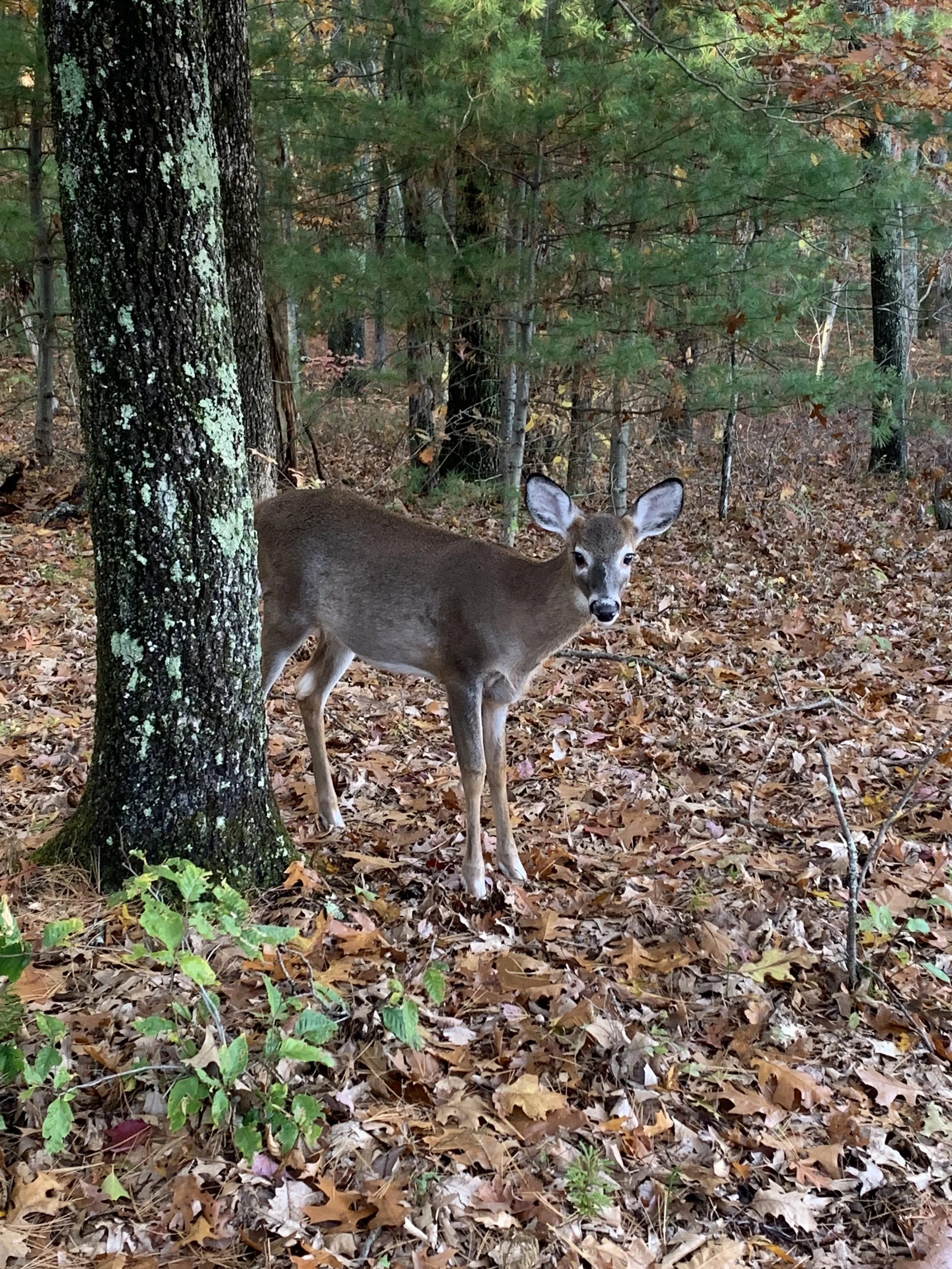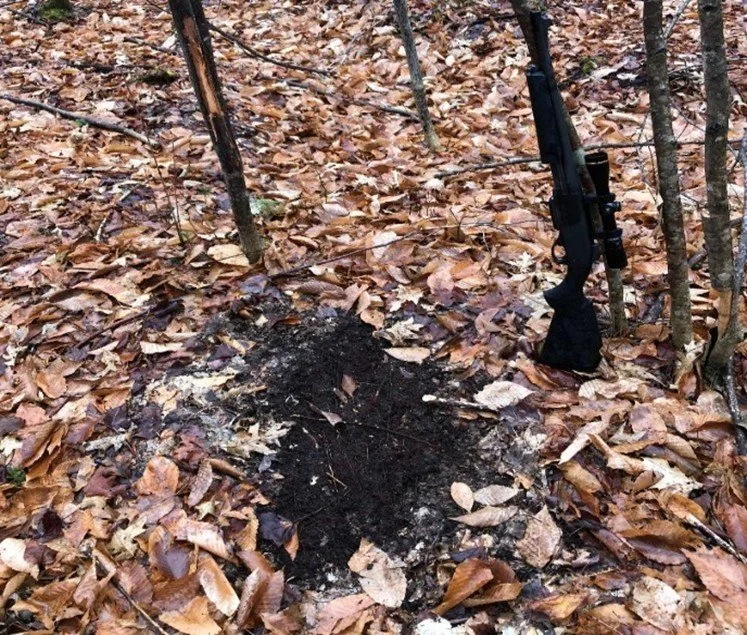Wear Orange for Hunters, Wear Blue for Deer
Shared by Sam B.
GLLT properties are open to hunting and late October and November brings the most popular hunting season in Maine, Firearms Deer Season. Beginning Saturday, November 1st and continuing Monday through Saturday for the next 4 weeks, about 140,000 licensed hunters will take to the woods and fields in search of white-tailed deer.
Based upon past results it’s expected that about 30% of the hunters will be successful. In 2024 the GLLT towns of Lovell, Stoneham, Stow and Sweden combined for 190 deer taken.
Signs of the Rut
Firearms deer hunting season typically occurs at the same time as the deer mating season which is also known as “The Rut”. During the Rut, bucks (male deer) will wander outside their usual home region in search of does (female deer). Their travel, combined with shorter daylight hours, results in increased deer and automobile collisions during this season.
Rival bucks will often compete for does and even spar with their antlers. They also leave signs known as scrapes and rubs. It’s a common belief that these signs are to mark their territory and to warn off other bucks, but some experts believe that bucks are not territorial and that the signs are actually to communicate with does.
A large scrape with a rub nearby.
A well-worn scrape. Photos of scrapes and rubs often include the rifle as a comparison to judge their size.
Scrapes are patches made in the ground where a buck will dig and scrape out dirt and leaves with their hooves similar to a dog after finishing their business. However, the buck will completely clear the patch to expose fresh soil clear of leaves. The size can vary but they are generally 12-24” wide and 18-30” long.
Scrapes are commonly made under a small overhanging branch. The buck will chew and twist this “licking branch’ to leave their scent. To complete the scrape they will pee in the scrape and then leave one footprint as their signature.
Rubs are vertical marks on trees where deer, typically bucks, have stripped the bark to remove velvet from their antlers and communicate with other deer nearby.
Bucks make rubs by grating their antlers and forehead against trees leaving gashes and stripping the bark. In addition, they will also leave scent and an oily substance from a gland in their forehead.
Rubs are usually made on small to medium-sized trees. Some believe that you can tell the size of the deer by the depth, height and length of the rub.
A well-worn scrape. Photos of scrapes and rubs often include the rifle as a comparison to judge their size.
Most rubs are made and visited by bucks for only a single year, however other rubs known as “signpost rubs”, are used by multiple bucks and often year after year. These rubs are generally on larger trees and deeper and wider than other rubs. They can signify a deer travel route or that a larger buck beds in the area.
Why Hunters Wear Blaze Orange
Over the years State Fish & Wildlife Departments have instituted safety regulations and measures for all types of hunting. These are particularly important with the wave of hunters hitting the woods for Firearms Deer Season.
One such regulation in Maine is the requirement that each licensed hunter wear two pieces of hunter orange or “Blaze Orange” clothing during the Firearms Deer Season. The first being “a solid-colored hunter orange hat” and the second a “jacket, vest, coat or poncho, that covers the torso and must be a minimum of 50% hunter orange in color (camouflage orange patterns of at least 50% orange are legal).”
While Blaze Orange is only required for hunters, I highly recommend it for anyone who heads to the woods during deer season. As a hunter I appreciate it as a courtesy and a sign that they’re aware of the season. It also provides me with better recognition of who’s in the area and the opportunity to change my hunting plans if needed.
So, from a hunter’s perspective, please wear orange if you’re in the woods during this time of year and thank you if you already do.
The benefits of Blaze Orange were first reported in a Field & Stream magazine article by Frank Woolner in October 1960 entitled “Hunter Orange—Your Shield of Safety.” In the article Woolner described the process and results of a scientific study conducted between October 1959 through January 1960 at Fort Devens, Massachusetts. This was a comprehensive scientific study where 1,100 soldiers were screened and selected by optometrists to represent the eyesight of the US adult male population even including almost 100 with color-deficient vision.
The objective of the study was to identify which color or colors were most visible across a wide range of field conditions and environments. These included:
late-season foliage and early winter snowfall,
in brush, fields, evergreens and hardwood forests
mid-day and low light conditions and
distances ranging from 25 to 100 yards.
A total of more than 22, 000 observations were recorded in 3 field tests. The soldiers were asked to identify one of six colors (White, Bright Red, Neon Red, Arc Yellow, Fire Orange, and Blaze Orange) on pop up targets and to shoot only the white targets within 4 seconds.
The results showed that Blaze Orange was the only color that was never confused with another.
So now we know that humans see and identify Blaze Orange better than other colors but what about deer? What colors do they see?
What Do Deer See?
While humans have trichromatic vision, which adds a sensitivity to red and orange hues from long-wavelength light, deer have dichromatic vision, so they see in shades of blue, green and purple and cannot really see orange. They see it as a shade of faded yellow.
Deer eyesight also differs from humans in other ways with several advantages and disadvantages:
Their eyesight is 20/60 as compared to humans at 20/20. While they cannot see sharp details, they can spot small movements at long distances.
A deer’s eyes are located on the sides of their heads. This gives them a 300 to 310 degree field of vision enabling them to spot potential predators and other threats. In contrast humans have only a 180-degree field of vision.
Deer eyes are capable of “cyclovergence” that allows them to rotate and keep their eyes on the horizon with a wide field of view even while they may be feeding with their nose facing downward.
They see about 18 times better than humans during the twilight hours of dusk and dawn.
Deer are estimated to see blue, violet and gray colors 20 times better than humans. It’s believed that these shades almost appear to glow.
So, as Firearms Deer Season begins in Maine remember these points:
- If you want to be seen and not surprise hunters wear Blaze Orange or
- if you want to be seen and not surprise deer wear Blue
- Or maybe you could wear both!






